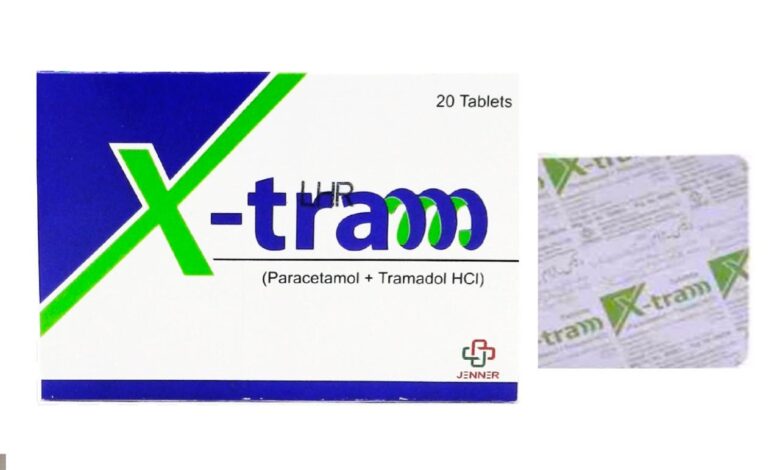Xtram: Uses, Dosage, Side Effects, Addiction

What is Xtram?
Xtram is a brand of oral tramadol tablet 50mg produced by Saga Laboratories. The Xtram plus variant contains Tramadol and paracetamol 37.5mg and 325mg respectively. Tramadol is a controlled substance. This means it can only be used with a doctor’s close supervision. Xtram belongs to a class of drugs called opioid agonists. A class of drugs is a group of medications that work in a similar way. These drugs are often used to treat similar conditions.
Xtram is used to treat moderate to severe pain. Xtram may be used as part of a combination therapy. This means you may need to take it with other medications.
How Xtram works
Xtram works by changing how your brain senses pain. Xtram is similar to substances in your brain called endorphins. Endorphins bind to receptors (parts of cells that receive a certain substance). The receptors then decrease the pain messages that your body sends to your brain. Xtram works in a similar way to decrease the amount of pain your brain thinks you’re having.
How should I take Xtram?
Xtram tablet is usually taken with or without food every 4 to 6 hours as needed. Do not take more medication as a single dose or take more doses per day than prescribed by your doctor. Taking more Xtram than prescribed by your doctor or in a way that is not recommended may cause serious side effects or death.
Your doctor may start you on a low dose of Xtram and gradually increase the amount of medication you take, not more often than every 3 days. Do not stop taking Xtram without talking to your doctor. Your doctor will probably decrease your dose gradually. If you suddenly stop taking Xtram, you may experience withdrawal symptoms such as nervousness; panic; sweating; difficulty falling asleep or staying asleep; runny nose, sneezing, or cough; pain; hair standing on end; chills; nausea; uncontrollable shaking of a part of your body; diarrhea; or rarely, hallucinations (seeing things or hearing voices that do not exist).
What are the side effects of Xtram?
Xtram oral tablet may cause drowsiness. You should not drive, use heavy machinery, or perform any dangerous activities until you know how this drug affects you. Xtram may also cause other side effects.
More common side effects
The more common side effects of Xtram can include:
- dizziness
- headache
- drowsiness
- nausea and vomiting
- constipation
- lack of energy
- sweating
- dry mouth
- itching
If these effects are mild, they may go away within a few days or a couple of weeks. If they’re more severe or don’t go away, talk to your doctor or pharmacist.
Serious side effects
Call your doctor right away if you have serious side effects. Call 911 if your symptoms feel life-threatening or if you think you’re having a medical emergency. Serious side effects and their symptoms can include the following:
- Serotonin syndrome. Symptoms can include:
- fast heart rate
- high blood pressure
- body temperature that’s higher than normal
- reflexes that are stronger than normal
- lack of coordination (control of your movements)
- nausea and vomiting
- diarrhea
- agitation
- hallucinations (seeing or hearing things that aren’t real)
- coma
- Serious breathing problems. Symptoms can include:
- slowed breathing rate
- very shallow breathing (little chest movement with breathing)
- fainting, dizziness, or confusion
- Physical dependence and withdrawal when stopping the drug. Symptoms can include:
- feeling irritable, anxious, or restless
- trouble sleeping
- increased blood pressure
- fast breathing rate
- fast heart rate
- dilated (large) pupils
- teary eyes
- runny nose
- yawning
- nausea, vomiting, and a loss of appetite
- diarrhea and stomach cramps
- sweating
- chills
- muscle aches, back pain, or joint pain
- Adrenal insufficiency. Symptoms can include:
- long-lasting tiredness
- muscle weakness
- pain in your abdomen
- Androgen deficiency. Symptoms can include:
- tiredness
- trouble sleeping
- decreased energy
- Seizures
- Addiction or misuse of this drug
What medications can interact with Xtram?
Xtram oral tablet can interact with other medications, vitamins, or herbs you may be taking. An interaction is when a substance changes the way a drug works. This can be harmful or prevent the drug from working well.
To help avoid interactions, your doctor should manage all of your medications carefully. Be sure to tell your doctor about all medications, vitamins, or herbs you’re taking. To find out how this drug might interact with something else you’re taking, talk to your doctor or pharmacist.
Examples of drugs that can cause interactions with Xtram are listed below.
Drugs you should not use with Xtram
Do not take these drugs with Xtram. Doing so can cause dangerous effects in the body. Examples of these drugs include:
- Carbamazepine. Taking this medication with Xtram may make Xtram less effective in relieving your pain. It also decreases the amount of Xtram in your body and increases your risk of seizures.
Interactions that increase your risk of side effects from other drugs
Taking Xtram with certain medications raises your risk of side effects from those drugs. This is because the amount of those drugs in your body may be increased. Examples of these drugs include:
- Depression drugs, such as sertraline, fluoxetine, paroxetine, citalopram, escitalopram, duloxetine, or venlafaxine
- You may have increased levels of serotonin (a hormone in your body). This can cause a condition called serotonin syndrome. Symptoms can include feeling agitated or restless, a fast heartbeat, increased body temperature, nausea, or vomiting.
- If you take one of these drugs with Xtram, your doctor may monitor you more often and adjust your dosage of the drug as needed.
- Monoamine oxidase inhibitors (MAOIs), including isocarboxazid, phenelzine, or selegiline
- You may have increased levels of serotonin (a hormone in your body). This can cause a condition called serotonin syndrome. Symptoms can include feeling agitated or restless, a fast heartbeat, increased body temperature, nausea, or vomiting.
- If you take one of these drugs with Xtram, your doctor may monitor you more often and adjust your dosage of the drug as needed.
- Linezolid
- You may have increased levels of serotonin (a hormone in your body). This can cause a condition called serotonin syndrome. Symptoms can include feeling agitated or restless, a fast heartbeat, increased body temperature, nausea, or vomiting.
- If you take this drug with Xtram, your doctor may monitor you more often. They may also adjust your dosage of Xtram as needed.
- Lithium
- You may have increased levels of serotonin (a hormone in your body). This can cause a condition called serotonin syndrome. Symptoms can include feeling agitated or restless, a fast heartbeat, increased body temperature, nausea, or vomiting.
- If you take this drug with Xtram, your doctor may monitor you more often. If you have symptoms of serotonin syndrome, your doctor may switch you to a different drug that doesn’t interact with Xtram.
- St. John’s wort
- You may have increased levels of serotonin (a hormone in your body). This can cause a condition called serotonin syndrome. Symptoms can include feeling agitated or restless, a fast heartbeat, increased body temperature, nausea, or vomiting.
- If you take this drug with Xtram, your doctor may monitor you more often and adjust your dosage of St. John’s wort as needed.
- Headache drugs, such as sumatriptan, rizatriptan, or zolmitriptan
- You may have increased levels of serotonin (a hormone in your body). This can cause a condition called serotonin syndrome. Symptoms can include feeling agitated or restless, a fast heartbeat, increased body temperature, nausea, or vomiting.
- If you take one of these drugs with Xtram, your doctor may monitor you more often and adjust your dosage of the drug as needed.
- Hypnotics, such as zolpidem
- You may have slowed breathing, decreased blood pressure, a decreased heart rate, or confusion.
- If you take one of these drugs, talk with your doctor on whether Xtram is safe for you. Your doctor may prescribe a lower dosage of the hypnotic for you.
- Benzodiazepines, such as alprazolam, clonazepam, diazepam, or lorazepam
- You will be at increased risk of confusion, slowed or stopped breathing, decreased blood pressure, a decreased heart rate, coma, or death.
- If you take one of these drugs, talk with your doctor on whether Xtram is safe for you. Your doctor may prescribe a lower dosage of the benzodiazepine drug for you.
- Anti-psychotic drugs, such as chlorpromazine or thioridazine
- You may have slowed breathing, decreased blood pressure, a decreased heart rate, or confusion.
- If you take one of these drugs, talk with your doctor about whether Xtram is safe for you. Your doctor may prescribe a lower dosage of the antipsychotic drug for you.
- Anesthesia drugs, such as succinylcholine, pentothal, or propofol
- You may have slowed breathing, decreased blood pressure, a decreased heart rate, or confusion.
- If you take one of these drugs, talk with your doctor about whether Xtram is safe for you. Your doctor may prescribe a lower dosage of the anesthesia drug for you.
- Opioid drugs for pain, such as hydrocodone, oxycodone, or morphine
- You will be at increased risk of confusion, slowed or stopped breathing, decreased blood pressure, a decreased heart rate, coma, or death.
- If you take one of these drugs, talk with your doctor about whether Xtram is safe for you. Your doctor may prescribe a lower dosage of either Xtram or the other opioid drug.
- Digoxin
- If you take this drug with Xtram, your doctor may monitor the amount of digoxin in your body.
- Warfarin
- If you take this drug with Xtram, your doctor may monitor the amount of warfarin in your body and your INR (international normalized ratio) more often. They may also adjust your warfarin dosage as needed.
Interactions that increase your risk of side effects from Xtram
If you use Xtram with certain drugs, you may have more side effects. This is because the amount of tramadol in your body may be increased. If you take one of these drugs with Xtram, your doctor may monitor you more often. They may also adjust your Xtram dosage as needed. Examples of these drugs include:
- Antibiotics, such as erythromycin
- Antidepressants, such as amitriptyline
- Antifungal drugs, such as voriconazole or ketoconazole
- Heart rhythm drugs, such as quinidine
- Protease inhibitors, such as ritonavir, atazanavir, or darunavir
Disclaimer: Our goal is to provide you with the most relevant and current information. However, because drugs interact differently in each person, we cannot guarantee that this information includes all possible interactions. This information is not a substitute for medical advice. Always speak with your healthcare provider about possible interactions with all prescription drugs, vitamins, herbs and supplements, and over-the-counter drugs that you are taking.
FDA warnings
- This drug has several boxed warnings. A boxed warning is the most serious warning from the U.S. Food and Drug Administration (FDA). It alerts doctors and patients about drug effects that may be dangerous.
- Addiction and misuse warning: This drug can lead to addiction and misuse, which can result in overdose and death. To help avoid these problems, take this drug exactly as prescribed by your doctor. If you have any concerns about this warning, talk with your doctor.
- Risk Evaluation and Mitigation Strategy (REMS): Because of this drug’s risk of abuse and addiction, the FDA requires that the drug’s manufacturer provide a REMS program. Under the requirements of this REMS program, the drug manufacturer must develop educational programs regarding the safe and effective use of opioids for your doctor.
- Slowed or stopped breathing warning: This drug can slow or stop your breathing. If this isn’t treated immediately, it can cause death. This risk is highest within three days of starting the drug or increasing your dosage.
- Accidental ingestion warning: If anyone, especially children, takes a dose of this drug by accident even once, it can cause death. This drug should be stored out of reach of children.
- Life-threatening effects for children warning: In some cases, children’s bodies can process this drug too quickly. This can lead to slowed breathing and death. This drug shouldn’t be used in children younger than 12 years of age. It should also not be used in children younger than 18 years of age who have certain risk factors, or who have just had a tonsillectomy or adenoidectomy.
- Neonatal opioid withdrawal syndrome warning: If you use this medication for a long time while you’re pregnant, it can cause withdrawal in your baby. Withdrawal in your baby can lead to death. Symptoms of withdrawal can include irritability, hyperactivity, unusual sleep patterns, and a high-pitched cry. They can also include tremor, vomiting, diarrhea, and failure to gain weight.
- Interactions with certain drugs warning: Taking Xtram with certain drugs can cause varied serious effects. These effects include increased Xtram levels, possibly leading to seizures and serotonin syndrome. They also include reduced effectiveness of Xtram, and opioid withdrawal symptoms. The drugs that can cause these effects include amiodarone, quinidine, erythromycin, ketoconazole, ritonavir, and similar medications.
- Interactions with benzodiazepines warning: Taking Xtram with benzodiazepines and other similar drugs can cause very serious effects. These effects can include severe fatigue, slowed breathing, coma, and death.
Other warnings
This drug comes with several other warnings.
Seizures warning
Xtram can cause or worsen seizures. Your risk of seizures is higher if you’re taking other certain medications. These drugs include other opioid pain drugs or certain medications for depression, other mood disorders, or psychosis. If you take too much Xtram, you may be treated with a medication called naloxone. This drug also raises your risk of seizures.
Allergy warning
Xtram can cause a severe allergic reaction. Symptoms can include:
- trouble breathing
- swelling of your face, lips, throat, or tongue
- severe itching
- hives (itchy welts)
- blistering or peeling skin
If you have an allergic reaction, call your doctor or local poison control center right away. If your symptoms are severe, call 911 or go to the nearest emergency room.
Don’t take this drug again if you’ve ever had an allergic reaction to it or other opioids before. Taking it again could be fatal (cause death).
Alcohol interaction
The use of drinks that contain alcohol can increase your risk of certain side effects from Xtram. These include slowed breathing, decreased heart rate, decreased blood pressure, or confusion. You should not drink alcohol while taking Xtram.
Warnings for people with certain health conditions
For people with seizures: If you have seizures or a history of seizures, Xtram can cause or worsen seizures. Talk with your doctor about whether Xtram is safe for you.
For people with mental health problems: If you have thoughts about intentionally hurting yourself, or have hurt yourself, do not take Xtram.
For people with addiction problems: If you have problems with addiction, such as addiction to alcohol or drugs, do not take Xtram. Also avoid this drug if you have a history of addiction.
For people with head injuries: Xtram can increase the pressure inside your head. This can worsen your condition or make it harder for doctors to diagnose or find the cause of problems in your brain. Talk with your doctor about whether Xtram is safe for you.
For people with stomach problems: Xtram can make certain stomach problems worse. It can also make it harder for doctors to diagnose or find the cause of problems. Talk with your doctor about whether Xtram is safe for you.
For people with kidney problems:
- Xtram immediate-release tablet: If you have kidney problems or a history of kidney disease, you may not be able to clear this drug from your body well. This may increase the levels of Xtram in your body and cause more side effects.
- Xtram extended-release tablet: If you have severe kidney problems, you should not use the extended-release forms of Xtram.
For people with liver problems:
- Xtram immediate-release tablet: If you have liver problems or a history of liver disease, your body may not be able to process this drug well. This may increase the levels of Xtram in your body and cause more side effects.
- Xtram extended-release tablet: If you have severe liver problems, you should not use the extended-release forms of Xtram.
For people with breathing problems: Xtram may slow your breathing and cause shallow breathing. Shallow breathing means you take small, short breaths. If you already have a breathing problem, such as asthma, talk with your doctor about whether this drug is safe for you.
Warnings for other groups
For pregnant women: Xtram is a category C pregnancy drug. That means two things:
- Research in animals has shown adverse effects to the fetus when the mother takes the drug.
- There haven’t been enough studies done in humans to be certain how the drug might affect the fetus.
Talk to your doctor if you’re pregnant or planning to become pregnant. This drug should only be used if the potential benefit justifies the potential risk to the fetus. Call your doctor right away if you become pregnant while taking this drug.
For women who are breastfeeding: Xtram may pass into breast milk and cause serious effects in a child who is breastfed. These effects can include slowed breathing and death.
Xtram isn’t recommended for use by breastfeeding women. Talk to your doctor if you breastfeed your child. You’ll need to decide whether to stop breastfeeding or stop taking this medication.
For seniors: The kidneys or liver of older adults may not work as well as they used to. This can cause your body to process drugs more slowly. As a result, more of a drug stays in your body for a longer time. This raises your risk of side effects. Seniors 65 years of age and older are at higher risk of side effects from the extended-release forms of this drug.
For children:
- Xtram immediate-release tablet: It’s not known if this drug is safe and effective for children. It should not be used in children younger than 17 years old.
- Xtram extended-release tablet: It’s not known if this drug is safe and effective for children. It should not be used in people younger than 18 years old.
Take as directed
Xtram oral tablet is used for short-term or long-term treatment. Your length of treatment depends on how severe your pain is. It comes with serious risks if you don’t take it as prescribed.
If you stop taking the drug suddenly or don’t take it at all: Your pain may continue. If you stop taking the drug suddenly, you may have symptoms of withdrawal, which can include:
- feeling irritable, anxious, or restless
- trouble sleeping
- increased blood pressure
- fast breathing rate
- fast heart rate
- dilated (large) pupils
- teary eyes
- runny nose
- yawning
- nausea, vomiting, and loss of appetite
- diarrhea and stomach cramps
- sweating
- chills
- muscle aches, back pain, or joint pain
If you miss doses or don’t take the drug on schedule: Your medication may not work as well or may stop working completely. For this drug to work well, a certain amount needs to be in your body at all times.
If you take too much: You could have dangerous levels of the drug in your body. Symptoms of an overdose of this drug can include:
- breathing that’s slow or shallow
- trouble speaking
- confusion
- extreme tiredness
- cold and clammy skin
- muscle weakness
- constricted (very small) pupils
- seizures
- dangerously slow heart rate
- low blood pressure
- dangerous heart problems such as an irregular heart rhythm or cardiac arrest (when the heart suddenly stops beating)
- coma
- death
If you think you’ve taken too much of this drug, call your doctor or seek guidance from the American Association of Poison Control Centers at 800-222-1222 or through their online tool. But if your symptoms are severe, call 911 or go to the nearest emergency room right away.
What to do if you miss a dose: Take your dose as soon as you remember. If you remember just a few hours before your next scheduled dose, take only one dose. Never try to catch up by taking two doses at once. This could result in dangerous side effects.
How to tell if the drug is working: You should feel less pain.





